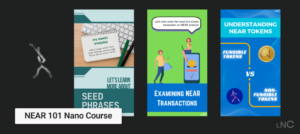Our donation example enables to forward NEAR Tokens to an account while keeping track of it. It is one of the simplest examples on making a contract handle tranfers.

Frontend of the Donation App
Obtaining the Donation Example
You have two options to start the Donation Example.
- You can use the app through
Github Codespaces, which will open a web-based interactive environment. - Clone the repository locally and use it from your computer.
| Codespaces | Clone locally |
|---|---|
🌠https://github.com/near-examples/donation-examples.git |
Structure of the Example
The example is divided in two main components:
- The smart contract, available in two flavors: rust and javascript
- The frontend, that interacts with an already deployed contract.
“`bash
┌── sandbox-ts # sandbox testing
│ ├── src
│ │ └── main.ava.ts
│ ├── ava.config.cjs
│ └── package.json
├── src # contract’s code
│ ├── contract.ts
│ ├── model.ts
│ └── utils.ts
├── package.json # package manager
├── README.md
└── tsconfig.json # test script
“`
“`bash
┌── tests # workspaces testing
│ ├── workspaces.rs
├── src # contract’s code
│ ├── donation.rs
│ └── lib.rs
├── Cargo.toml # package manager
├── README.md
└── rust-toolchain.toml
“`
Frontend
The donation example includes a frontend that interacts with an already deployed smart contract, allowing user to donate NEAR tokens to a faucet service.
Running the Frontend
To start the frontend you will need to install the dependencies and start the server.
cd frontend
yarn
yarn devGo ahead and login with your NEAR account. If you don’t have one, you will be able to create one in the moment. Once logged in, input the amount of NEAR you want to donate and press the donate button. You will be redirected to the NEAR Wallet to confirm the transaction. After confirming it, the donation will be listed in the “Latest Donations”.
Understanding the Frontend
The frontend is a Next.JS project generated by create-near-app. Check DonationsTable.jsx and DonationsForm.jsx to understand how components are displayed and interacting with the contract.
An interesting aspect of the donation example is that it showcases how to retrieve a result after being redirected to the
NEAR wallet to accept a transaction.
Smart Contract
The contract exposes methods to donate tokens (donate), and methods to retrieve the recorded donations (e.g. get_donation_for_account).
Testing the Contract
The contract readily includes a set of unit and sandbox testing to validate its functionality. To execute the tests, run the following commands:
“`bash
cd contract-ts
yarn
yarn test
“`
“`bash
cd contract-rs
cargo test
“`
he `integration tests` use a sandbox to create NEAR users and simulate interactions with the contract.
Deploying the Contract to the NEAR network
In order to deploy the contract you will need to create a NEAR account.
“`bash
# Create a new account pre-funded by a faucet
near create-account
“`
“`bash
# Create a new account pre-funded by a faucet
near account create-account sponsor-by-faucet-service
“`
Go into the directory containing the smart contract (cd contract-ts or cd contract-rs), build and deploy it:
cargo near build
cargo near deploy <accountId>o interact with your contract from the [frontend](https://raw.githubusercontent.com/Techbridge3/docs/master/docs/3.tutorials/examples/#frontend), simply replace the variable `CONTRACT_NAME` in the `index.js` file.
CLI: Interacting with the Contract
To interact with the contract through the console, you can use the following commands
Get donations
“`bash
near view donation.near-examples.testnet get_donations ‘{“from_index”: “0”,”limit”: “10”}’
“`
“`bash
near contract call-function as-read-only donation.near-examples.testnet get_donations json-args ‘{“from_index”: “0”,”limit”: “10”}’ network-config testnet now
“`
Get beneficiary
“`bash
near view donation.near-examples.testnet get_beneficiary
“`
“`bash
near contract call-function as-read-only donation.near-examples.testnet get_beneficiary json-args {} network-config testnet now
“`
Get number of donors
“`bash
near view donation.near-examples.testnet number_of_donors
“`
“`bash
near contract call-function as-read-only donation.near-examples.testnet number_of_donors json-args {} network-config testnet now
“`
Get donation for an account
“`bash
# Require accountId
near view donation.near-examples.testnet get_donation_for_account ‘{“account_id”:
“`
“`bash
# Require accountId
near contract call-function as-read-only donation.near-examples.testnet get_donation_for_account json-args ‘{“account_id”:
“`
Donate to the contract
“`bash
# Replace
# Require deposit
near call donation.near-examples.testnet donate –accountId
“`
“`bash
# Replace
# Require deposit
near contract call-function as-transaction donation.near-examples.testnet donate json-args {} prepaid-gas ‘30.0 Tgas’ attached-deposit ‘0.1 NEAR’ sign-as
“`
f you’re using your own account, replace `donation.near-examples.testnet` with your `accountId`.
Moving Forward
A nice way to learn is by trying to expand a contract. Modify the donation example so it accumulates the tokens in the contract
instead of sending it immediately. Then, make a method that only the beneficiary can call to retrieve the tokens.
Versioning for this article
At the time of this writing, this example works with the following versions:
– near-cli: `4.0.13`
– node: `18.19.1`
– rustc: `1.77.0`

